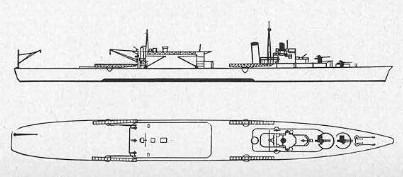![]() The Pacific War Online Encyclopedia
The Pacific War Online Encyclopedia
|
| Previous: Chitose | Table of Contents | Next: Chittagong |
 Wikipedia Commons |  ONI 41-42 |
| Tonnage | 11,023 tons standard |
| Dimensions | 603'5" by 61'8" by 23'8" 183.92m by 18.80m by 7.21mhttps://commons.wikimedia.org/wiki/File:127mmAA_on_IJN_Chitose_in_1938.jpg |
| Maximum speed | 29 knots |
| Aircraft | 4 catapults 12 seaplanes 12 Type 'A' midget submarines |
| Armament | 2x2 5"/40
dual-purpose guns 12 25mm AA guns |
| Machinery |
2-shaft mixed geared turbine
(44,000 shp) and diesel (12,800 bhp) 4 Kampon boilers |
| Bunkerage | 3600 tons fuel oil |
| Range | 8000 nautical miles (15,000 km) at 18 knots |
| Displacement | 13,647 tons standard |
| Dimensions | 631'7" by 68'3" by 24'8" 192.51m by 20.80m by 7.52m |
| Maximum speed | 28.9 knots |
| Complement |
800 |
| Aircraft | 590'6" (180.0m) flight deck 2 elevators 30 aircraft |
| Armament | 4x2 5"/40
dual-purpose guns 10x3 25mm AA guns |
| Machinery | 2-shaft mixed geared turbine
(44,000 shp) and diesel (12,800 bhp) 4 Kampon boilers |
| Bunkerage | 1000 tons fuel oil |
| Range | 11,000 nautical miles (20,000 km) at 18 knots |
| Modification | Armament increased to 16x3 25mm guns in July 1943 |
The Chitoses were
completed in 1938 as the first Japanese seaplane
carriers built as such from the keel up. By the time of the Pacific
War, they also carried midget
submarines,
which they could launch from two large steel doors in the stern. They
had been designed as part of the "shadow fleet" of vessels that could
be rapidly converted to oilers, submarine tenders, or light aircraft carriers
should war break out, in
an attempt to get around the limits imposed by naval
disarmament treaties.
Among their unusual features was mixed propulsion,
with diesel for economy and geared turbines for higher speed. The ships
also had an unusual profile, with a very large seaplane handling area
aft, a service area amidships which was covered by a large platform,
and the bridge superstructure well forward.
The Chitoses were taken in hand for conversion in 1942-1944 to light carriers. The service area platform and associated machinery was removed, the bridge superstructure cut down, and the main deck converted to a hangar deck, over which a flush flight deck was constructed. They were not particularly successful, in part because there were few carrier-qualified pilots left by 1944 to fly off of them.
| Chiyoda | Hashirajima Withdrawn 1943-2 Recommissioned 1943-12-21 (Yokosuka) |
Sunk by aircraft and gunfire 1944-10-25 off Cape Engano |
| Chitose | with Fourth
Surprise Attack Group (Legaspi)
in the Palaus
Withdrawn 1942-11-28 Recommissioned 1943-11-1 (Sasebo) |
Sunk by aircraft 1944-10-25 off Cape Engano |
 |
 |
 |
 |
References
Jentschura, Jung, and Mickel (1977)
The Pacific War Online Encyclopedia © 2007, 2009, 2015 by Kent G. Budge. Index